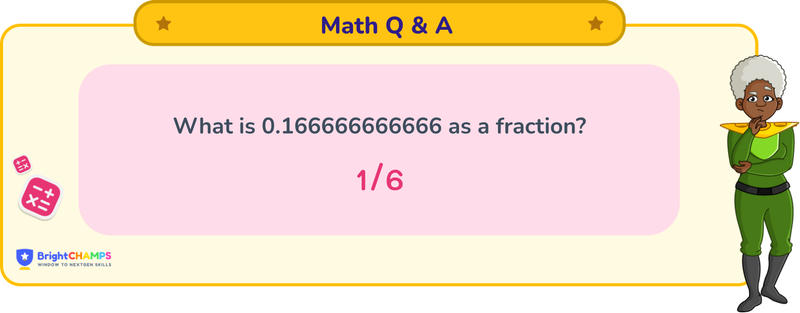
 178 Learners
178 LearnersLast updated on August 5, 2025

0.166666666666 as a Fraction

Numbers can be categorized into different types. Fraction is one of its kind. It is always represented in the form of p/q, where p is the numerator and q is the denominator. Fraction represents a whole and a fractional part. Decimals represent the fractional part of numbers. For example, 1/2, the numbers in decimal are expressed with a decimal point (.), For example, 0.166666666666, we are going to learn how to convert a decimal to a fraction.
What is 0.166666666666 as a Fraction?
 Answer
Answer
The answer for 0.166666666666 as a fraction will be 1/6.
Explanation
Converting a decimal to a fraction is a task for students that can be done easily. You can follow the steps mentioned below to find the answer.
Step 1: Firstly, any repeating decimal number should be converted to a fraction for easy calculation. Here, 0.166666666666 is the number on the numerator and the base number 1 will be the denominator. Then, 0.166666666666 becomes 0.166666666666/1.
Step 2: To convert the repeating decimal to a fraction, let's represent 0.166666666666 as \( x \). So, \( x = 0.166666666666\ldots \).
Step 3: Multiply both sides of the equation by 10 to shift the decimal point: 10\( x \) = 1.666666666666\ldots
Step 4: Subtract the original equation (Step 2) from this new equation: 10( x ) - ( x ) = 1.666666666666
0.166666666666\ldots 9\( x \) = 1.5
Step 5: Solve for ( x ): ( x = frac{1.5}{9} = frac{3}{18} )
Step 6: Simplify the fraction by dividing by the GCD of 3 and 18, which is 3: (frac{3}{18} = frac{1}{6})
Thus, 0.166666666666 can be written as a fraction 1/6.
Important Glossaries for 0.166666666666 as a Fraction
- Fraction: A numerical quantity that is not a whole number, representing a part of a whole.
- Decimal: A number that uses the base ten and includes a decimal point to separate the whole part from the fractional part.
- Numerator: The top part of a fraction, indicating how many parts of the whole are being considered.
- Denominator: The bottom part of a fraction, showing how many parts make up a whole.
- Repeating Decimal: A decimal in which one or more digits repeat infinitely.




